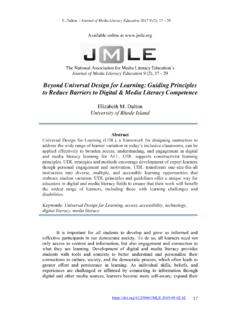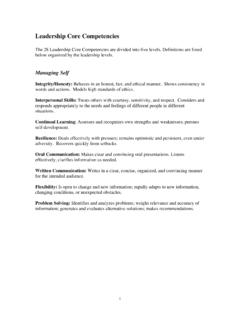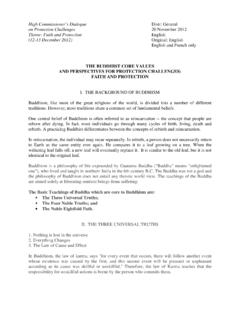Transcription of Five Guiding Principles of a Successful Center of Excellence
1 1 five Guiding Principles of a Successful Center of Excellence2 ContentsWhat Is a Center of Excellence ? ..3 Keys to a Successful Center of Excellence ..6#1 Standardization ..7#2 Leveraging #3 Measuring Performance ..10#4 Guidance and Governance ..13#5 Balance and Subject Matter Experts ..14 Get on the Path to Excellence ..17 Management Consulting at Perficient 183 What Is a Center of Excellence ?At some point in time, most companies find it beneficial to develop a Center of Excellence (CoE). The priorities of a CoE span several areas, with different sponsors, and are expected to change over time. Nonetheless, the fundamental Principles of the CoE group should be clear and consistent, as these are critical to the CoE s continuous success and Center of Excellence is a (typically small) team of dedicated individuals managed from a common central point, separate from the functional areas that it supports within a practice or organization.
2 Sometimes referred to as a competency or capability Center , the CoE is often the team leading the way in exploring and adopting new technology tools, techniques, or group operates across areas within the practice or organization, with a focus on: Providing thought leadership and direction Establishing and promoting best practices Research and development, to provide appropriate recommendations Support and education Performing other similar functions in specific focus areas considered critical to the success of the overall organization or practice that the CoE supports4In addition to its core focus areas, the CoE can also add value by contributing to.
3 Optimizing the organization or practice by centralizing resources with high-demand and unique knowledge or skills and streamlining their contributions across a wide range of areas Improving ROI through the identification and development of reusable assets Reducing delivery times, development, and maintenance costs by increasing efficiencies and leveraging reusable assets Identifying and reducing duplication of effort across initiatives within the practice or enterpriseDeveloping and maintaining a catalog of reusable assets will add tremendous, and tangible value, and enable project teams to rely on proven, predictable results while avoiding common Development Standard Performance Indicators Industry-Proven Practices and Trends Business Process OptimizationCenter of Excellence6 Keys to a Successful Center of ExcellenceAs a key to success, every Center of Excellence should have a set of clearly and concisely defined Guiding Principles that will provide its direction and focus.
4 We suggest these five areas as a starting point for establishing and successfully evolving a CoE:1. Standardization2. Leveraging assets3. Measuring performance4. Guidance and governance5. Balance and subject matter expertsLet s take a closer look at #1 StandardizationAt its core , the main purpose of a CoE is to define and develop standards and best practices. This includes developing and documenting templates, blue prints, and repeatable processes and methodologies for all significant work efforts such as: Estimating level of effort Standardizing format of documentation and deliverables Quality assurance Testing and validation Technical architecture maintenance Performance monitoring and optimization Program coding (standards and style) General project and resource planningThese best practices should consist of a blend of documented and generally accepted industry standards, along with the CoE s own practical experiences and successes.
5 Prioritizing to begin with the most significant and ubiquitous work, all efforts and products should be reviewed by the CoE team and then categorized. General questions the CoE should ask include: Have we solved this issue in the past? If so, how? What worked or didn t work? What lessons did we learn? Is there an industry standard that we can use as a baseline for comparative purposes?To be Successful , members of the CoE need to be steadily in tune with the latest industry trends, established practices, and emerging thought streams. All of the members of the CoE should be self-starters, who are interested in continuous learning and improvement of their skills and , any artifacts produced by the CoE are to be considered living documents.
6 These documents can and will evolve, change, and in some cases become obsolete and in need of replacement, based on the evolving needs of the industry, as well as the CoE itself acquiring new knowledge and experiences. 8#2 Leveraging AssetsThe Center of Excellence team should strive to identify all of the usable assets that exist within the organization and the CoE itself. These assets can be physical or intellectual, and typically include: Human Assets: These individuals or designated teams possess very specific or unique skillsets, deep and/or broad experience, and exude qualities that characterize the organization. Additionally, these people should have demonstrated an interest in contributing to the CoE s initiatives, as well as have (or manage) the time and availability to do so.
7 Relationships: It is beneficial to include individuals inside or outside of the organization who have an influence in the industry. These key relationships may consist of specific customer or stakeholder contacts, vendor relationships and memberships, partnerships, and organized groups. Code: This includes actual program code, models or modules, design patterns, algorithms (possibly expressed only in pseudo code), templates, tools, and utilities developed by the organization. These will provide the basis for repeatable, consistent coding practices throughout the organization. Artifacts: These are documents describing policies, guidelines, advice, industry best practices, organizational best practices, constraints, and considerations.
8 Additional artifacts include documented results of past brainstorming, troubleshooting, and post- resolution review of these assets may be obvious and easy to recognize, while others may only be revealed during actual project assets whether intellectual or physical must then be harvested or developed by the CoE for use within the organization, and if unique and meaningful enough, be branded and introduced to the industry at large to generate revenue directly through sales or indirectly by establishing assets will play a key role in simplifying and improving the efforts and processes of the organization that the CoE supports and will directly affect cost.
9 Because of this, the CoE needs to have the ability and the authority to continually inspect all current and past projects and deliverables, looking for sharable assets that can be beneficially leveraged throughout the organization in one or more #3 Measuring PerformanceAs with any Successful endeavor, the CoE must develop the ability to track, measure, and report on the performance of the team s initiatives across all areas of its efforts, as well as specific metrics within the organization itself. This is critical to the growth and evolution of the CoE, since clearly demonstrating success will be a major factor in buy-in and support from stakeholders throughout the organization, particularly upper measuring relies on having an established baseline against which to compare performance.
10 At the start of an initiative, the CoE team must immediately identify and establish baselines for the work efforts being performed or to be performed. These baselines can be developed from internal organizational experiences, industry-accepted and published standards, or both. For deliverables to internal stakeholders, the CoE should establish Service Level Agreements (SLAs), to define clearly and concisely what targets and thresholds are to be used to define a Successful performance allows the CoE to set expectations for current and new work, thus providing answers to certain key questions such as: Are our design or resource presumptions reasonable?










